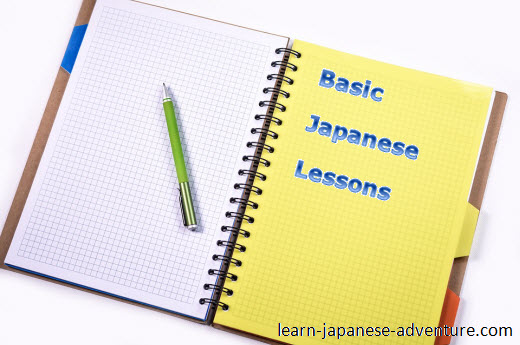- Home
- Basic Lessons
Free Japanese Lessons Online - Basic
I attended part-time Japanese lessons in two Japanese language schools for a total of five years and was very lucky to meet many great Japanese native teachers.
Along the learning journey, my Japanese teachers helped me to build up my knowledge of many basic Japanese grammars, giving lots of examples to enhance the understanding of the many important grammars.

I firmly believe that it's the solid foundation which I had built up in the Basic Japanese courses that helped in the smooth transition to the advanced level without much difficulty.
Wonder how I learned my basic Japanese lessons?
I will organize these lessons in the same sequence as what I have been through which I think will benefit you. Go through all the free lessons to have a good understanding of the basic Japanese.
A good solid foundation of the basics will certainly benefit you when you plan to go a step higher to the intermediate lessons.
If you have not gone through the hiragana lessons yet, please get familiarize first before starting the following lessons.
Following are the Basic Japanese Lessons...
In the first lesson, we will go through together some Japanese Greetings which you can use them to greet your Japanese friends when you meet them. You might have already known some of them.
You will learn to use Japanese nouns to form simple sentences. Some Japanese particles such as topic markers は (wa), も (mo) and question word か (ka) will be discussed here.
Learn how to use one noun to modify another noun in this lesson. There are various meanings when using this sentence structure.
4. Japanese Demonstrative Pronouns and Demonstrative Adjectives
Check out the difference between demonstrative pronouns and demonstrative adjectives. Learn all the こ・そ・あ・ど series of demonstrative words.
Find out the differences between い-adjectives and な-adjectives and how to used them as predicates and noun modifiers.
Discover how to connect 2 Japanese adjectives to form a sentence using te-form. Find out how to change to te-form for both i-adjectives and na-adjectives.
7. arimasu and imasu - How to express existence in Japanese?
Do you know how to express existence in Japanese? In this Japanese lesson see how to do that using 2 Japanese verbs あります (arimasu) and います (imasu).
8. How to use Numbers in Japanese?
Study how to incorporate numbers in Japanese into sentences and see how particle と (to) can be used to connect 2 subjects.
Japanese likes and dislikes are actually na-adjectives. See how to form sentences using them. Learn also how to say preference in Japanese.
10. Japanese Time Expression in sentences
How to incorporate Japanese time expression into a sentence using Noun sentence or Verb sentence? Check out more in this lesson.
Japanese particles play a very important role in forming a Japanese sentence. However they can be very confusing sometimes. This lesson introduces few of the basic particles.
12. Japanese Time Duration, Distance, Length and Quantity?
In this Japanese lesson, learn how to express the approximate Japanese time duration, distance, length and quantity in a sentence and the related question word.
13. Japanese Nouns Part 3 - Actions Before and After Noun
This lesson on Japanese nouns explains the two expressions that specify the actions perform before and after nouns.
14. Japanese Particles change in negative answers
You need to change the Japanese particles when giving negative answer to a Yes/No question. It's also important on where to add the particle は (wa) for negative answer.
15. Japanese Particles か (ka) and も (mo) with Question Words
In this Japanese lesson, learn to combine Japanese particles か (ka) and も (mo) with question words to form words like something, someone, somewhere, nothing, nobody and nowhere.
16. Japanese particles と (to) and で (de)
Most Japanese particles have more than one function. で (de) specifies the vehicle used, indicates the place where the action is taken, and shows the mean or tool used to perform an action. と (to) is used when taking action with someone.
Learn how to change to past tense of Japanese verbs, nouns, na-adjectives and i-adjectives. Understand how to get stem of masu-form for verbs.
Get to know the 3 groups of Japanese verbs and how to form them. Learn also the 2 types of speech in Japanese - Polite Style and Plain Style.
How to change Japanese verbs from dictionary-form to ます-form (masu-form) and ない-form (nai-form) for all 3 groups of verbs? Find out more here...
20. Japanese Verbs on Give and Receive
Study the three Japanese verbs あげます (agemasu), もらいます (moraimasu) and くれます (kuremasu) on gving and receiving. In addition, know the rules that decide which verb to use for giving.
In this Japanese lesson, discover how to make て-form (te-form) of Japanese verbs from dictionary-form and see what is the basic function of te-form.
22. Japanese Verbs on Progress Action, Habitual Action and Occupation
Get to know て-form + います (te-form + imasu) in Japanese verbs on progress action, habitual action and one's occupation.
23. Japanese Verbs of Motion and How to Make Request in Japanese
Particle を (wo) is used instead of で (de) for Japanese verbs of motion. Learn also how to make a request in Japanese using te-form.
24. Japanese Particles は (wa) and が (ga)
In this Japanese lesson, discover what are the main differences between Japanese particles は (wa) and が (ga). See how they are used in different sentences.
Know the 2 types of Japanese adverbs, one which can be derived from adjectives while the other one being the regular adverbs.
26. Japanese Past Tense in Plain Form
Learn how to make Japanese past tense in Plain form for verbs, nouns, na-adjectives and i-adjectives in order to make complicated sentences.
27. Japanese Particle と (to) for Quotation
Japanese particle と (to) is commonly used for quotation in a sentence. Find out how to make sentences using it.
Japanese noun modifier is used when you want to describe a noun with more information. Discover the rules to follow when using it.
29. Japanese Verbs on State Continuation
Study another function of Japanese verbs て-form + います (te-form + imasu) on state continuation.
30. Japanese Verbs - Transitive and Intransitive verbs
Learn what are the differences between transitive and intransitive Japanese verbs and how to use them with many examples.
31. Japanese Verbs on State Continuation with Transitive and Intransitive verbs
In this Japanese lesson, learn more about Japanese verbs on state continuation with transitive and intransitive verbs and what are the differences between them.
Not having enough? In the intermediate lessons section on this site there are even more Japanese lessons online prepared for you.
Ready Set Speak Sale! Get 40% OFF Forever on Premium & Premium PLUS plans! Ends on 18 Apr 2025
The link above is an affiliate link, which means that I would earn a commission (at no extra cost to you) if you do end up purchasing the related learning course.
Buy me a coffee








Facebook Comments
Don’t see the comments box? Log in to your Facebook account, give Facebook consent, then return to this page and refresh it.